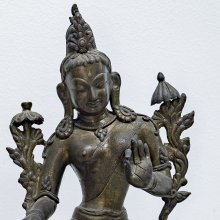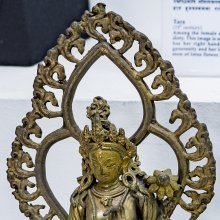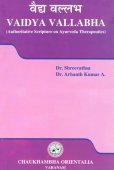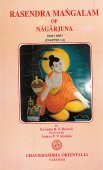Hridaya, Hṛdaya: 32 definitions
Introduction:
Hridaya means something in Buddhism, Pali, Hinduism, Sanskrit, Marathi, Hindi. If you want to know the exact meaning, history, etymology or English translation of this term then check out the descriptions on this page. Add your comment or reference to a book if you want to contribute to this summary article.
The Sanskrit term Hṛdaya can be transliterated into English as Hrdaya or Hridaya, using the IAST transliteration scheme (?).
Alternative spellings of this word include Hraday.
Images (photo gallery)
In Hinduism
Natyashastra (theatrics and dramaturgy)
Source: archive.org: The mirror of gesture (abhinaya-darpana)A type of glance (or facial expression): Hṛdaya: unsteady, flurried, the pupils moving somewhat (anaglulita), the lids recurved; it is used for mediocre things.

Natyashastra (नाट्यशास्त्र, nāṭyaśāstra) refers to both the ancient Indian tradition (shastra) of performing arts, (natya—theatrics, drama, dance, music), as well as the name of a Sanskrit work dealing with these subjects. It also teaches the rules for composing Dramatic plays (nataka), construction and performance of Theater, and Poetic works (kavya).
Shilpashastra (iconography)
Source: Google Books: The Theory of Citrasutras in Indian PaintingAccording to the Matsya Purāṇa, Hṛdaya (heart) from neck to heart is 12 aṅgulas.

Shilpashastra (शिल्पशास्त्र, śilpaśāstra) represents the ancient Indian science (shastra) of creative arts (shilpa) such as sculpture, iconography and painting. Closely related to Vastushastra (architecture), they often share the same literature.
Ayurveda (science of life)
Source: Google Books: Essentials of AyurvedaThe name Hṛdaya (हृदय, “for heart”) is quite meaningful as it indicates the three phasas—receiving, supplying and movement of the cardiac cycle. Heart is the source of life as none can live if it stops. That is why it has been said by earlier sages as the seat of consciousness. Heart is the receptacle of rasa and rakta (blood) which it distributes to the whole body for nourishment and also draws out impurities from the same. This goes on incessantly like a cycle. The lotus-like heart is situated in chest, flanked by lungs on both sides. Below on the right side is liver and on the left is spleen.
Source: Cogprints: Concepts of Human Physiology in AyurvedaStructure and Functioning of Heart: Appearance of heart is similar to that of an inverted bud of lotus. When the individual is ‘awake’, this lotus blossoms forth and when he is ‘asleep’, it closes up (Suśrutasaṃhitā Śārirasthāna 4/32). The narrow apex of the heart is directed downwards and broader base is directed upwards when the individual is standing. This observation is reflected in this explanation saying that the heart looks like an inverted bud of lotus. To indicate ‘life’ and ‘death’, the terms ‘awake’ and ‘asleep’ are often used in Sanskrit literature. So, meaning of this statement is that functioning of heart continues till the death of an individual.
Source: gurumukhi.ru: Ayurveda glossary of termsHṛdaya (हृदय):—Heart

Āyurveda (आयुर्वेद, ayurveda) is a branch of Indian science dealing with medicine, herbalism, taxology, anatomy, surgery, alchemy and related topics. Traditional practice of Āyurveda in ancient India dates back to at least the first millenium BC. Literature is commonly written in Sanskrit using various poetic metres.
Purana and Itihasa (epic history)
Source: archive.org: Shiva Purana - English Translation1) Hṛdaya (हृदय) refers to the “heart” of Śiva from which Rudra was born, according to the Śivapurāṇa 2.2.2. Accordingly, as Brahmā said:—“Originally when Śiva was separated from Śakti and was pure consciousness alone, He was attributeless, free from alternatives, devoid of forms and beyond the existent and non-existent. [...] Viṣṇu was born of His left (vāmāṅga) and I, Brahmā, of his right side (dakṣiṇāṅga), O great sage, Rudra was born of his heart (hṛdaya). I became the creator (Brahmā); Viṣṇu the cause of sustenance; Rudra the author of dissolution. Thus Sadāśiva, manifested himself in three forms”.
According to the Śivapurāṇa 2.2.16:—“[...] The same Supreme Ātman [viz., Paramātma], :ord Śiva manifests in three different ways due to Māyā. The lord is independent in his divine sports. Viṣṇu is born of his left limb. I am born of the right limb. You are born of the heart (hṛdaya) of Śiva and are his full-fledged incarnation. Thus, O lord, we have become three, with different forms. We are the sons of Śivā and Śiva which, O eternal one, you must note”.
2) Hṛdaya (हृदय) refers to the “cardiac region”, where Satī stabilized the udāna-wind while in a yogic trance, according to the Śivapurāṇa 2.2.30. Accordingly as Brahmā narrated to Nārada:—“[...] having sipped water duly, covering up her body entirely with her cloth she closed her eyes and remembered her lord. She then entered the yogic trance. Keeping her face steady she balanced the winds Prāṇa and Apāna [i.e., prāṇāpāna]. She then lifted up the wind Udāna from the umbilical region, stabilised it in the cardiac region (hṛdaya) took it through the throat and finally fixed it in the middle of the eyebrows. She desired to cast-off her body due to her anger with Dakṣa. She desired to burn off the body and retain the pure wind by yogic means. In this posture she remembered the feet of her lord and nothing else”.
Source: Cologne Digital Sanskrit Dictionaries: The Purana IndexHṛdaya (हृदय).—The horse of Bhoja which would go at a stretch 100 yojanas.*
- * Brahmāṇḍa-purāṇa III. 71. 71-2.

The Purana (पुराण, purāṇas) refers to Sanskrit literature preserving ancient India’s vast cultural history, including historical legends, religious ceremonies, various arts and sciences. The eighteen mahapuranas total over 400,000 shlokas (metrical couplets) and date to at least several centuries BCE.
Vastushastra (architecture)
Source: McGill: The architectural theory of the MānasāraHṛdaya (हृदय, “heart”).—Mānasāra LXX, 111 exhorts the sthapati and the sthāpaka to install the image in the sanctuary of their hearts (hṛdaya) as well. In fact, the “radiance” of the duo stem from having installed the radiant deity in their he arts. The heart is the “center of being”, so to speak, where the cognitive and affective faculties meet. Thus. the act of installing the deity therein perspicuously connects divine seeing and knowing.
Source: Brill: Śaivism and the Tantric Traditions (architecture)Hṛdaya (हृदय) refers to the “heart”, according to the Devyāmata (in the section śalyoddhāra-paṭala or “excavation of extraneous substances”).—Accordingly, “[...] If [someone] scratches his breast, there is the bone of an animal or hair [at a depth of] one and a half cubits underground. [The officiant] should remove that extraneous thing carefully. If [someone] touches his heart (hṛdaya-sparśa), there is [an extraneous thing] related to it at a depth up to the heart (hṛdaya). [...]

Vastushastra (वास्तुशास्त्र, vāstuśāstra) refers to the ancient Indian science (shastra) of architecture (vastu), dealing with topics such architecture, sculpture, town-building, fort building and various other constructions. Vastu also deals with the philosophy of the architectural relation with the cosmic universe.
Jyotisha (astronomy and astrology)
Source: Wisdom Library: Brihat Samhita by VarahamihiraHṛdaya (हृदय) or Hṛd refers to the “heart”, according to the Bṛhatsaṃhitā (chapter 8), an encyclopedic Sanskrit work written by Varāhamihira mainly focusing on the science of ancient Indian astronomy astronomy (Jyotiṣa).—Accordingly, “The Nakṣatras—Rohiṇī and Kṛttikā, form the body of the Vatsara Puruṣa, the two Āṣāḍhas form his navel, Āśleṣā forms the heart [i.e., hṛd] and Maghā, the heart-bladder; when benefíc planets pass through these, there will be happiness in the land; if malefic planets should pass through the body, there will be suffering from fire and winds; if they should pass through the navel, there will be suffering from starvation; if they should pass through the heart-bladder, roots and fruits will suffer, and if they should pass through the heart [i.e., hṛdaya], crops will perish”.
Source: Wikibooks (hi): Sanskrit Technical TermsHṛdaya (हृदय).—Circum-radius. Note: Hṛdaya is a Sanskrit technical term used in ancient Indian sciences such as Astronomy, Mathematics and Geometry.

Jyotisha (ज्योतिष, jyotiṣa or jyotish) refers to ‘astronomy’ or “Vedic astrology” and represents the fifth of the six Vedangas (additional sciences to be studied along with the Vedas). Jyotisha concerns itself with the study and prediction of the movements of celestial bodies, in order to calculate the auspicious time for rituals and ceremonies.
Shaktism (Shakta philosophy)
Source: Google Books: ManthanabhairavatantramHṛdaya (हृदय) refers to the “heart”, according to the Kaulajñānanirṇaya.—Accordingly, “The Nameless (energy) [i.e., anāmā] is fixed in the Heart [i.e., hṛdaya]. This is the Gesture (mudrā) that bestows the goddess. If one sees her in the End of the Twelve, she shines (like) a necklace of gems. This is the Gesture (mudrā) called Anāmā; once (it is) known (one attains) the (liberated) sky-faring state. O beloved, one must break though the door which, endowed with consciousness, is sealed with the Five Seals (of the lower Wheels) and is well obstructed by the chain (of the door). [...]”.

Shakta (शाक्त, śākta) or Shaktism (śāktism) represents a tradition of Hinduism where the Goddess (Devi) is revered and worshipped. Shakta literature includes a range of scriptures, including various Agamas and Tantras, although its roots may be traced back to the Vedas.
Shaivism (Shaiva philosophy)
Source: Brill: Śaivism and the Tantric TraditionsHṛdaya (हृदय) refers to the “heart”, according to the Paramārthasāra with Yogarāja’s Paramārthasārasaṃgrahavivṛti commentary.—Accordingly, “one whose heart (hṛdaya) has been penetrated/transmuted by the power of divine grace (i.e., śaktipāta)”.
Source: ORA: Amanaska (king of all yogas): (Shaivism)Hṛdaya (हृदय) refers to one’s “understanding”.—In his commentary to the Svacchandatantra (11.197), Kṣemarāja provides the following definition: “Kuhaka is that which causes astonishment and convinces those of limited understanding (mita-hṛdaya). It is chiefly magic”. In his commentary on the Netratantra (18.89), Kṣemarāja glosses kuhakāni as: “Deceitful (things) such as amulets of control, witches, etc.”. These glosses affirm that kuhaka can be understood more specifically to mean an astonishing, magical feat rather than its general sense of something that causes astonishment, the latter definition being that of Dhātupāṭha 10.443.

Shaiva (शैव, śaiva) or Shaivism (śaivism) represents a tradition of Hinduism worshiping Shiva as the supreme being. Closely related to Shaktism, Shaiva literature includes a range of scriptures, including Tantras, while the root of this tradition may be traced back to the ancient Vedas.
Dharmashastra (religious law)
Source: HAL: The function of the Vṛṣasārasaṃgraha in the Śivadharma corpus (ds)Hṛdaya (हृदय) refers to “one’s heart”, according to the Vṛṣasārasaṃgraha: A Sanskrit text of twenty-four chapters contained in the Śivadharma corpus dealing with Dharma (religious duties).—Accordingly, [verse 11.59]: “Brahmā’s heart is Viṣṇu. Viṣṇu’s heart is Śiva. Śiva’s heart is the Junctures of the day. Therefore, he should worship the Junctures”.

Dharmashastra (धर्मशास्त्र, dharmaśāstra) contains the instructions (shastra) regarding religious conduct of livelihood (dharma), ceremonies, jurisprudence (study of law) and more. It is categorized as smriti, an important and authoritative selection of books dealing with the Hindu lifestyle.
In Buddhism
Mahayana (major branch of Buddhism)
Source: Wisdom Library: Maha Prajnaparamita SastraHṛdaya (हृदय, “heart”) (Pali, Hadaya) refers to one of the thirty-substances of the human body according to the Visuddhimagga, as mentioned in an appendix of the 2nd century Mahāprajñāpāramitāśāstra chapter 32-34. The Mahāprajñāpāramitāśāstra mentions thirty-six substances [viz., hṛdaya]; the Sanskrit sources of both the Lesser and the Greater Vehicles, physical substances are 26 in number while the Pāli suttas list thirty-once substances.

Mahayana (महायान, mahāyāna) is a major branch of Buddhism focusing on the path of a Bodhisattva (spiritual aspirants/ enlightened beings). Extant literature is vast and primarely composed in the Sanskrit language. There are many sūtras of which some of the earliest are the various Prajñāpāramitā sūtras.
Tibetan Buddhism (Vajrayana or tantric Buddhism)
Source: academia.edu: A Critical Study of the Vajraḍākamahātantrarāja (II)Hṛdaya (हृदय) is the name of a Vākchomā (‘verbal secrect sign’) which has its meaning defined as ‘vīra’ according to chapter 8 of the 9th-century Vajraḍākamahātantrarāja, a scripture belonging to the Buddhist Cakrasaṃvara (or Saṃvara) scriptural cycle. These Vākchomās (viz., hṛdaya) are meant for verbal communication and can be regarded as popular signs, since they can be found in the three biggest works of the Cakrasaṃvara literature.
Source: OSU Press: Cakrasamvara Samadhi1) Hṛdaya (हृदय) or “heart” is associated with Drumacchā and Vajradehaka, according to the Cakrasaṃvara-maṇḍala or Saṃvaramaṇḍala of Abhayākaragupta’s Niṣpannayogāvalī, p. 45 and n. 145; (Cf. Cakrasaṃvaratantra, Gray, David B., 2007).—The Cakrasaṃvara mandala has a total of sixty-two deities. [...] Three concentric circles going outward, the body, speech and mind wheels (kāya-vāka-citta), in the order: mind (blue), speech (red), and body (white), with eight Ḍākinīs each in non-dual union with their Ḍākas, "male consorts".
Associated elements of Drumacchā and Vajradehaka:
Circle: kāyacakra (mind-wheel) (blue);
Ḍākinī (female consort): Drumacchā;
Ḍāka (male consort): Vajradehaka;
Bīja: māṃ;
Body-part: arms;
Pīṭha: Mālava;
Bodily constituent: hṛdaya (heart);
Bodhipakṣa (wings of enlightenment): samādhīndriya (faculty of concentration).
2) Hṛdaya (हृदय) refers to the “heart” and is associated with the syllable kāṃ, according to the Cakrasaṃvara Samādhi [i.e., Cakrasamvara Meditation] ritual often performed in combination with the Cakrasaṃvara Samādhi, which refers to the primary pūjā and sādhanā practice of Newah Mahāyāna-Vajrayāna Buddhists in Nepal.—Accordingly, “[Do caturviṃśati-aṅga nyāsa; Touch twenty-one parts of one’s body with right middle finger, and recite seed syllables] ... Kāṃ on the heart (kāṃ hṛdaya)”.
Source: MDPI Books: The Ocean of HeroesHṛdaya (हृदय) refers to the “heart”, according to the 10th-century Ḍākārṇava-tantra: one of the last Tibetan Tantric scriptures belonging to the Buddhist Saṃvara tradition consisting of 51 chapters.—Accordingly, “[...] (The meaning of the letter he, i.e., the emptiness of cause and so on, etc.—) The letter he is [as follows]: From the heart (hṛdaya), [he should visualize] all [deities], such as Heruka, [who] reside on their own circles. [Vajra-]holders and others are originating; [he should know] all [of them] originating through visualization. That [letter he represents the principle that] the cause is empty by nature; there is no conceptualization of cause and so on as selves. That [letter he refers to] the selflessness of phenomenal existences by nature, [or the state of] being empty [Emptiness] brings the meditative union [...]”.

Tibetan Buddhism includes schools such as Nyingma, Kadampa, Kagyu and Gelug. Their primary canon of literature is divided in two broad categories: The Kangyur, which consists of Buddha’s words, and the Tengyur, which includes commentaries from various sources. Esotericism and tantra techniques (vajrayāna) are collected indepently.
Languages of India and abroad
Marathi-English dictionary
Source: DDSA: The Molesworth Marathi and English Dictionaryhṛdaya (हृदय).—n (S) The heart or the mind; the faculty or the seat of feeling and thought. 2 The bosom or the breast, lit. fig. 3 fig. Mind, meaning, intent, design or drift of the mind: also the scope, purport, or significance (of a speech, a sentence, an action).
Source: DDSA: The Aryabhusan school dictionary, Marathi-Englishhṛdaya (हृदय).—n The heart or the mind. The bosom. Intent. The scope, purport.
Marathi is an Indo-European language having over 70 million native speakers people in (predominantly) Maharashtra India. Marathi, like many other Indo-Aryan languages, evolved from early forms of Prakrit, which itself is a subset of Sanskrit, one of the most ancient languages of the world.
Sanskrit dictionary
Source: DDSA: The practical Sanskrit-English dictionaryHṛdaya (हृदय).—
1) The heart, soul, mind; हृदये दिग्धशरैरिवाहतः (hṛdaye digdhaśarairivāhataḥ) Kumārasambhava 4.25; so अयोहृदयः (ayohṛdayaḥ) R.9.9; पाषाणहृदय (pāṣāṇahṛdaya) &c.
2) The bosom, chest, breast; बाणभिन्नहृदया निपेतुषी (bāṇabhinnahṛdayā nipetuṣī) R.11.19.
3) Love, affection.
4) The interior or essence of anything.
5) The secret science; अश्व°, अक्ष° (aśva°, akṣa°) &c.; ऋतुपर्णो नलसखो योऽश्वविद्यामयान्नलात् । दत्वाऽक्षहृदयं चास्मै सर्वकामस्तु तत्सुतः (ṛtuparṇo nalasakho yo'śvavidyāmayānnalāt | datvā'kṣahṛdayaṃ cāsmai sarvakāmastu tatsutaḥ) || Bhag.9.9.17.
6) True or divine knowledge.
7) The Veda.
8) Wish, intention; एवं विरिञ्चादिभिरीडितस्तद्विज्ञाय तेषां हृदयं तथैव (evaṃ viriñcādibhirīḍitastadvijñāya teṣāṃ hṛdayaṃ tathaiva) Bhāgavata 8.6.16.
9) = अहंकारम् (ahaṃkāram) q. v.; मनो विसृजते भावं बुद्धिरध्यवसायिनी । हृदयं प्रियाप्रिये वेद त्रिविधा कर्मचोदना (mano visṛjate bhāvaṃ buddhiradhyavasāyinī | hṛdayaṃ priyāpriye veda trividhā karmacodanā) Mahābhārata (Bombay) 12.248.1.
Derivable forms: hṛdayam (हृदयम्).
Source: Cologne Digital Sanskrit Dictionaries: Shabda-Sagara Sanskrit-English DictionaryHṛdaya (हृदय).—n.
(-yaṃ) 1. The mind, the seat or faculty of thought and feeling. 2. Knowledge. 3. Science. 4. The essence of anything. E. hṛ to take, kayan Unadi aff., duk augment.
Source: Cologne Digital Sanskrit Dictionaries: Benfey Sanskrit-English DictionaryHṛdaya (हृदय).—n. (cf. the last), 1. The heart, [Vikramorvaśī, (ed. Bollensen.)] [distich] 7. 2. The mind, [Pañcatantra] i. [distich] 198. 3. Knowledge, [Nala] 14, 21.
Source: Cologne Digital Sanskrit Dictionaries: Cappeller Sanskrit-English DictionaryHṛdaya (हृदय).—[neuter] the heart, as an organ of the body or as seat of the feelings, also the interior of the body i.[grammar], the centre or essence of anything etc.
Source: Cologne Digital Sanskrit Dictionaries: Monier-Williams Sanskrit-English Dictionary1) Hṛdaya (हृदय):—[from hṛd] n. (ifc. f(ā). ) the heart (or region of the heart as the seat of feelings and sensations; hṛdaye-√kṛ, ‘to take to heart’), soul, mind (as the seat of mental operations; capala-hṛdaya, ‘fickle-minded’), [Ṛg-veda] etc. etc.
2) [v.s. ...] the heart or interior of the body, [Ṛg-veda; Atharva-veda; Taittirīya-brāhmaṇa; Mahābhārata]
3) [v.s. ...] the heart or centre or core or essence or best or dearest or most secret part of anything, [Atharva-veda] etc. etc.
4) [v.s. ...] true or divine knowledge, [Monier-Williams’ Sanskrit-English Dictionary]
5) [v.s. ...] the Veda, [ib.]
6) [v.s. ...] science, [ib.]
7) [v.s. ...] (with prajāpateḥ) Name of a Sāman, [Indische Studien by A. Weber]
8) [v.s. ...] m. a [particular] Sunday, [Bhaviṣya-purāṇa, khaṇḍa 1 & 2: bhaviṣya-purāṇa & bhaviṣyottara-purāṇa]
9) Hṛdayā (हृदया):—[from hṛdaya > hṛd] f. Name of a mare, [Harivaṃśa]
10) Hṛdaya (हृदय):—[from hṛd] mfn. going to the heart, [Bhāgavata-purāṇa] ([from] hṛd + aya [Scholiast or Commentator])
Source: Cologne Digital Sanskrit Dictionaries: Yates Sanskrit-English DictionaryHṛdaya (हृदय):—(yaṃ) 1. n. Idem; knowledge.
Source: DDSA: Paia-sadda-mahannavo; a comprehensive Prakrit Hindi dictionary (S)Hṛdaya (हृदय) in the Sanskrit language is related to the Prakrit word: Hiaya.
[Sanskrit to German]
Sanskrit, also spelled संस्कृतम् (saṃskṛtam), is an ancient language of India commonly seen as the grandmother of the Indo-European language family (even English!). Closely allied with Prakrit and Pali, Sanskrit is more exhaustive in both grammar and terms and has the most extensive collection of literature in the world, greatly surpassing its sister-languages Greek and Latin.
Hindi dictionary
Source: DDSA: A practical Hindi-English dictionaryHṛdaya (हृदय) [Also spelled hraday]:—(nm) the heart; core, best part; darling (person); ~[kaṃpa] palpitation, heart-throb; ~[gata/stha] taken to heart, mentally assimilated; ~[grāhī] captivating, charming; ~[jña] who knows the heart, penetrating into the mind; -[daurbalya] weakness of heart, faint-heartedness; ~[vidāraka] heart-rending; ~[vedhī] heart-piercing, causing extreme anguish or mental agony; ~[śūnya/hīna] dry, hard-hearted, unfeeling; ~[sparśī] pathetic, touching, moving; ~[hārī] charming, attractive, gripping; —[ko chūnā] to touch one’s heart, to move; —[phaṭanā/vidīrṇa honā] the heart to rend, to be anguished; —[se lagānā] to embrace; to give a warm welcome.
...
Kannada-English dictionary
Source: Alar: Kannada-English corpusHṛdaya (ಹೃದಯ):—
1) [noun] the hollow muscular organ located behind the sternum and between the lungs which by its rhythmic contractions moves the blood through the body; the heart.
2) [noun] the part of the human body thought of as containing the heart; breast; the bosom.
3) [noun] the human heart considered as the centrJ or source of emotions, personality attributes, etc.
4) [noun] any of the noble qualities as kindliness, sympathy, compassion, benevolence, generosity, etc.
5) [noun] the essential part of anything.
6) [noun] a guarded secret.
Kannada is a Dravidian language (as opposed to the Indo-European language family) mainly spoken in the southwestern region of India.
Nepali dictionary
Source: unoes: Nepali-English DictionaryHṛdaya (हृदय):—n. 1. heart; 2. soul; mind; 3. conscience; 4. essence; core; 5. dearest person; 6. soft feelings; 7. bosom; chest; breast;
Nepali is the primary language of the Nepalese people counting almost 20 million native speakers. The country of Nepal is situated in the Himalaya mountain range to the north of India.
See also (Relevant definitions)
Starts with (+166): Hridaya-patala, Hridaya-vidaraka, Hridayabandhana, Hridayabene, Hridayabhara, Hridayabharana, Hridayabhedaka, Hridayabhedisu, Hridayabhijata, Hridayabodhika, Hridayacakra, Hridayacandra, Hridayacaura, Hridayacchid, Hridayachakra, Hridayachaura, Hridayachhid, Hridayachid, Hridayachora, Hridayacora.
Ends with (+177): Acaryahridaya, Adityahridaya, Ahridaya, Akarnahridaya, Aklinnahridaya, Akshahridaya, Ambikahridaya, Anantahridaya, Ananyahridaya, Antarhridaya, Ardrahridaya, Artahridaya, Asahridaya, Asarihridaya, Ashamkitahridaya, Ashmahridaya, Ashrvahridaya, Ashtangahridaya, Ashvahridaya, Atamkitahridaya.
Full-text (+617): Hridayavidh, Dvihridaya, Ashvahridaya, Hridayatman, Hridayangama, Hridayagrahin, Sahridaya, Suhridaya, Shunyahridaya, Hridayamgamata, Hridayadahin, Hridayashoshana, Hridayavant, Hridayadaurbalya, Hridayasthana, Bhiruhridaya, Kathinahridaya, Hridayalekha, Cakitahridaya, Vishahridaya.
Relevant text
Search found 113 books and stories containing Hridaya, Hṛdaya, Hrdaya, Hṛdayā; (plurals include: Hridayas, Hṛdayas, Hrdayas, Hṛdayās). You can also click to the full overview containing English textual excerpts. Below are direct links for the most relevant articles:
Garga Samhita (English) (by Danavir Goswami)
Verse 5.3.26 < [Chapter 3 - Akrūra’s Arrival]
Verse 5.6.34 < [Chapter 6 - Seeing Śrī Mathurā]
Verse 3.9.32 < [Chapter 9 - The Birth of Śrī Girirāja]
Sahitya-kaumudi by Baladeva Vidyabhushana (by Gaurapada Dāsa)
Text 9.7 < [Chapter 9 - Ornaments of Sound]
Text 9.3 < [Chapter 9 - Ornaments of Sound]
Text 10.87 < [Chapter 10 - Ornaments of Meaning]
Atharvaveda and Charaka Samhita (by Laxmi Maji)
Aṣṭāṅga Hṛdaya (Āyurveda book) < [Chapter 1 - Introduction]
Treatment of Upadaṃśa (syphilis) < [Chapter 3 - Diseases and Remedial measures (described in Atharvaveda)]
Treatment of Bhagandara (fistula in the anus) < [Chapter 3 - Diseases and Remedial measures (described in Atharvaveda)]
Rig Veda (translation and commentary) (by H. H. Wilson)
Chandogya Upanishad (Madhva commentary) (by Srisa Chandra Vasu)
Eight Adhyaya, Third Khanda (5 mantras)
Third Adhyaya, Twelfth Khanda (9 mantras)
Chaitanya Bhagavata (by Bhumipati Dāsa)
Verse 2.41 < [Chapter 2 - The Lord’s Manifestation at the House of Śrīvāsa and the Inauguration of Saṅkīrtana]
Verse 3.1.268 < [Chapter 1 - Meeting Again at the House of Śrī Advaita Ācārya]
Verse 2.5.125 < [Chapter 5 - Lord Nityānanda’s Vyāsa-pūjā Ceremony and His Darśana of the Lord’s Six-armed Form]
Related products
(+1 more products available)






